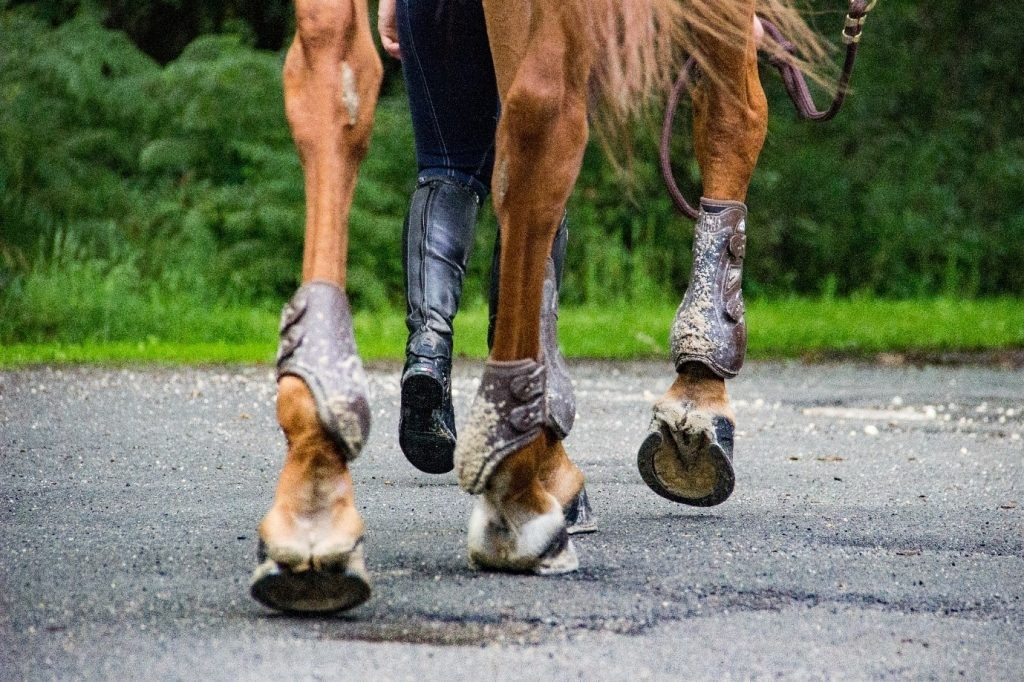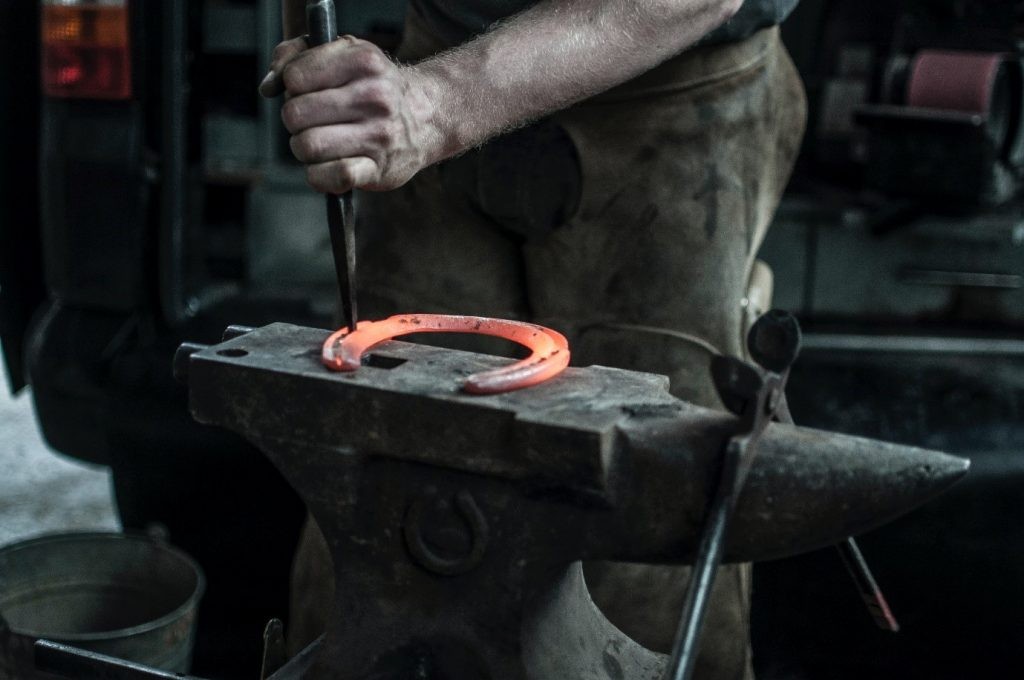At WHY.EDU.VN, we understand that you’re searching for clear, reliable information about Why Do Horses Wear Horseshoes. These seemingly simple pieces of metal play a vital role in equine care, protecting their hooves and enabling them to perform various tasks. Explore with us the world of equine podiatry and learn about hoof care and horseshoeing practices.
1. What Are Horseshoes?
A horseshoe is a U-shaped piece of metal, plastic, or composite material fitted to a horse’s hoof to protect it from wear and damage. Historically, they’ve enabled horses to work in diverse conditions and terrains. A horse with shoes is referred to as “shod,” while one without is “unshod” or “barefoot.”
Horseshoes are typically made of steel or aluminum, but other materials such as rubber or plastic are also used. They are attached to the hoof wall using nails, which, when properly placed by a skilled farrier, do not cause the horse any pain. In some cases, shoes may be glued on for temporary protection.
2. Why Do Horses Wear Shoes?
Horseshoes serve several essential functions for domesticated horses:
2.1. Hoof Protection and Durability
The primary reason horses wear shoes is to protect their hooves from excessive wear. In the wild, horses’ hooves naturally wear down as they roam across various terrains. However, domesticated horses, especially those performing strenuous activities like carrying riders, pulling carts, or participating in equestrian sports, experience accelerated hoof wear. Horseshoes act as a protective barrier, preventing the hooves from wearing down too quickly.
Think of horseshoes like the soles of our shoes. Just as our footwear protects our feet from the impact of walking on hard surfaces, horseshoes shield a horse’s hooves. This is particularly important for horses working on abrasive surfaces like pavement or rocky trails.
2.2. Traction and Grip
Horseshoes provide enhanced traction, which is crucial for horses working on slippery or uneven terrain. This is especially important for activities like:
- Riding on wet or muddy ground: Shoes with specific tread patterns can improve grip and prevent slipping.
- Pulling heavy loads: Horseshoes provide the necessary traction for pulling carts or carriages, ensuring stability and efficiency.
- Navigating icy conditions: Specialized shoes with studs or borium can offer superior grip on ice and snow.
The enhanced traction provided by horseshoes can significantly improve a horse’s performance and safety in various working conditions.
2.3. Corrective and Therapeutic Purposes
Horseshoes can also be used to correct gait abnormalities or provide support for horses with certain medical conditions. Corrective shoeing involves modifying the shape and fit of the shoe to address issues such as:
- Balance problems: Shoes can be designed to provide additional support to specific areas of the hoof, improving balance and stability.
- Gait abnormalities: Corrective shoeing can help to improve a horse’s stride and movement, reducing strain on joints and tendons.
- Hoof deformities: Shoes can be used to reshape and support hooves with cracks, flares, or other structural issues.
Therapeutic shoeing is often used to manage or alleviate pain associated with conditions like:
- Laminitis: Special shoes can provide support and cushioning to the affected hoof, reducing pain and promoting healing.
- Arthritis: Horseshoes can help to stabilize the joints and reduce stress, alleviating pain and improving mobility.
- Ringbone: Corrective shoeing can help to redistribute weight and reduce pressure on the affected area.
2.4. Performance Enhancement
In certain disciplines, horseshoes can be tailored to enhance performance. For instance:
- Racehorses: Lightweight aluminum shoes are commonly used to minimize weight and maximize speed.
- Dressage horses: Specialized shoes can improve balance and enhance movement in specific gaits.
- Jumping horses: Shoes with increased traction can provide better grip and stability during takeoff and landing.
A skilled farrier can work with trainers and veterinarians to design and fit shoes that optimize a horse’s performance in their chosen discipline.
2.5. Environmental Factors
Environmental conditions also play a significant role in determining the need for horseshoes. Horses living in wet or muddy environments may benefit from shoeing to prevent hoof infections and abscesses. Conversely, horses in dry, arid climates may require shoes to protect their hooves from cracking and drying out.
3. Do All Horses Need Shoes?
The question of whether all horses need shoes is a subject of ongoing debate. There’s no definitive answer, as the need for shoes depends on various factors, including the horse’s breed, job, environment, and individual hoof condition.
3.1. Arguments for Shoeing
- Protection: Shoes provide a protective barrier against hard or abrasive surfaces, reducing the risk of bruising, cracks, and other hoof injuries.
- Traction: Shoes enhance traction on slippery or uneven terrain, improving stability and preventing falls.
- Support: Shoes can provide additional support for horses with weak or compromised hooves, promoting healing and preventing further damage.
- Performance: Shoes can be customized to enhance performance in specific disciplines, optimizing balance, movement, and grip.
3.2. Arguments Against Shoeing
- Interference with natural hoof function: Some argue that shoes restrict the natural expansion and contraction of the hoof, which can impair circulation and overall hoof health.
- Potential for injury: Improperly fitted shoes can cause pressure sores, abscesses, and other foot problems.
- Cost: Shoeing can be an expensive undertaking, requiring regular visits from a qualified farrier.
- Unnecessary for some horses: Many horses can thrive without shoes, especially those with strong, healthy hooves and those engaged in light work on soft terrain.
3.3. Barefoot Trimming
An alternative to shoeing is barefoot trimming, which involves regularly trimming the hooves to maintain a natural shape and function. Proponents of barefoot trimming argue that it allows the hoof to develop its natural strength and resilience.
Barefoot trimming may be a suitable option for horses with strong, healthy hooves that are not subjected to strenuous work or harsh environments. However, it’s essential to consult with a qualified farrier or veterinarian to determine if barefoot trimming is appropriate for your horse.
4. The Pros and Cons of Shoeing a Horse
To help you make an informed decision about whether to shoe your horse, let’s examine the pros and cons of shoeing in more detail.
4.1. Benefits of Shoeing
| Benefit | Description |
|---|---|
| Protection | Adds durability and strength to the hooves, reducing the risk of injury when riding on hard ground or performing intensive work. |
| Slower Rate of Wear | Prevents the hooves from wearing out too quickly, which is especially helpful for horses involved in work that involves a lot of weight-bearing, such as carriage pulling. |
| Enhanced Performance | Improves performance in high-impact events such as jumping or cross country work. |
| Corrective Measures | Helps with balance issues or other problems with a horse’s gait and stride. Can also be used to correct chips or cracks in the hoof. |
| Increased Support | Provides additional support for horses that suffer from health conditions such as arthritis, ringbone, or laminitis. |


4.2. Cons of Shoeing
- Potential for Injury: Poorly fitted shoes or inept farriers can cause harm to the sensitive inner part of the hoof. A lost shoe can result in tendon sprains or damage to the hoof wall.
- Cost: Shoeing is generally more expensive than trimming alone.
- Dependence: Regular shoeing can make the hoof dependent on the shoe for support, potentially weakening the natural hoof structure over time.
- Reduced Sensation: Shoes can reduce the horse’s ability to feel the ground, which may affect balance and coordination.
- Risk of Infection: Nail holes can create entry points for bacteria and fungi, increasing the risk of hoof infections.
5. Pros and Cons of Going Barefoot
For those considering the barefoot approach, here’s a look at the advantages and disadvantages:
5.1. Benefits of Going Barefoot
| Benefit | Description |
|---|---|
| Cost-Effective | Trimming alone is usually less expensive than shoeing. |
| Enhanced Performance | Improves soundness and performance, especially during arena work, for some horses. |
| Natural State | Allows the horse to be as close to its natural state as possible, which some believe is healthier and more comfortable. |
5.2. Cons of Going Barefoot
- Increased Risk of Injury: Stone bruises or other injuries can occur during work, even with proper hoof maintenance and good nutrition.
- Increased Maintenance: Requires extra vigilance in checking, trimming, and caring for the feet and hooves.
- Need for Extra Protection: Temporary shoes or boots may still be needed for competing or hacking in wet, muddy, or icy conditions.
- Transition Period: Horses transitioning to barefoot may experience temporary discomfort or sensitivity as their hooves adapt.
- Not Suitable for All Horses: Barefoot trimming may not be appropriate for horses with weak or damaged hooves or those engaged in strenuous work.
6. How Do I Know if Shoeing Is Right for My Horse?
Deciding whether or not to shoe your horse requires careful consideration of several factors:
6.1. Type of Work
Consider the type of work your horse is doing. Horses engaged in strenuous activities like jumping, racing, or pulling heavy loads may benefit from the additional protection and support provided by shoes. Conversely, horses used for light riding or pasture grazing may not require shoes.
6.2. Ground Conditions
Assess the ground conditions where your horse spends most of its time. Horses working on hard, abrasive surfaces like pavement or rocky trails are more likely to need shoes than those on soft, grassy pastures.
6.3. Hoof Condition
Examine the overall health and condition of your horse’s hooves. Horses with strong, healthy hooves may be able to go barefoot, while those with weak, brittle, or damaged hooves may require the support and protection of shoes.
6.4. Medical Conditions
Consider any medical conditions your horse may have. Horses with laminitis, arthritis, or other foot problems may benefit from therapeutic shoeing to provide support and alleviate pain.
6.5. Consult Professionals
Consult with your veterinarian and farrier to get their expert opinions on whether shoeing is right for your horse. They can assess your horse’s individual needs and recommend the best course of action.
6.6. Changing Needs
Remember that your horse’s needs may change over time. A horse that thrives barefoot in the summer may require shoes in the winter to provide traction on ice and snow. Be prepared to adjust your approach as needed to ensure your horse’s comfort and well-being.
7. What Is a Person Who Shoes Horses Called?
A person who shoes horses is called a farrier. Farriers are skilled professionals who specialize in equine hoof care. Their responsibilities include:
- Trimming and shaping hooves: Farriers trim excess hoof growth to maintain proper balance and alignment.
- Making and fitting horseshoes: Farriers create custom horseshoes to fit each horse’s individual needs.
- Assessing hoof health: Farriers examine hooves for signs of injury, disease, or other problems.
- Providing corrective shoeing: Farriers use specialized techniques to address gait abnormalities and other foot problems.
Becoming a farrier requires extensive training and apprenticeship. Look for a farrier who is certified by a reputable organization and has a proven track record of providing quality hoof care.
8. What Happens During the Re-Shoeing Process?
The re-shoeing process typically involves the following steps:
- Removal of old shoes: The farrier carefully removes the old shoes using specialized tools.
- Hoof trimming: The farrier trims excess hoof growth to maintain proper balance and alignment.
- Hoof shaping: The farrier shapes the hoof to ensure a proper fit for the new shoe.
- Shoe fitting: The farrier selects a shoe that is the correct size and shape for the horse’s hoof.
- Shoe nailing: The farrier nails the shoe to the hoof wall using specialized horseshoe nails.
- Finishing: The farrier clinches the nails and files the hoof to create a smooth, comfortable finish.
9. How Often Should a Horse Be Re-Shod?
The frequency with which a horse needs to be re-shod depends on several factors, including:
- Hoof growth rate: Horses with faster hoof growth rates may need to be re-shod more frequently.
- Type of work: Horses engaged in strenuous activities may wear down their shoes more quickly.
- Ground conditions: Horses working on hard, abrasive surfaces may need to be re-shod more frequently.
As a general rule, horses should be re-shod every six to eight weeks. However, it’s essential to monitor your horse’s hooves and shoes regularly and adjust the re-shoeing schedule as needed.
9.1. Signs Your Horse Needs Re-Shoeing
- Loose or missing shoes
- Protruding nails
- Cracked or broken shoes
- Uneven hoof wear
- Changes in gait or movement
If you notice any of these signs, contact your farrier to schedule a re-shoeing appointment.
10. Horseshoes: Materials and Types
Horseshoes come in a variety of materials and styles, each designed for specific purposes.
10.1. Materials
- Steel: The most common material for horseshoes, steel is durable and provides good traction.
- Aluminum: Lighter than steel, aluminum shoes are often used for racing and other performance events.
- Titanium: Extremely lightweight and strong, titanium shoes are used in specialized applications.
- Plastic/Composite: These shoes offer cushioning and flexibility and are often used for therapeutic purposes.
- Rubber: Rubber shoes provide excellent shock absorption and are often used for horses with sensitive feet.
10.2. Types
- Plain Shoes: The most basic type of horseshoe, providing general protection and support.
- Bar Shoes: These shoes have a bar across the back, providing additional support to the heels and frog.
- Egg Bar Shoes: Similar to bar shoes but with a rounded shape, providing even more support and cushioning.
- Heart Bar Shoes: These shoes have a heart-shaped bar that provides support to the frog and promotes circulation.
- Wedge Shoes: These shoes have a wedge-shaped pad that elevates the heel, correcting gait abnormalities and providing support.
- Rim Shoes: These shoes have a raised rim that provides additional traction on slippery surfaces.
- Studded Shoes: These shoes have studs or caulks that provide maximum traction on ice and snow.
11. The Importance of a Skilled Farrier
The importance of a skilled and experienced farrier cannot be overstated. A good farrier will:
- Assess your horse’s individual needs and recommend the most appropriate type of shoe.
- Trim and shape your horse’s hooves properly to ensure balance and alignment.
- Fit the shoes correctly to prevent pressure sores, abscesses, and other foot problems.
- Monitor your horse’s hoof health and provide ongoing care and maintenance.
- Work closely with your veterinarian to address any medical conditions or gait abnormalities.
Choosing the right farrier is an investment in your horse’s health and well-being. Take the time to research and find a farrier who is qualified, experienced, and committed to providing quality hoof care.
12. Latest Advancements in Horseshoe Technology
The field of horseshoe technology is constantly evolving, with new materials, designs, and techniques being developed to improve equine hoof care. Some of the latest advancements include:
- 3D-printed horseshoes: Custom-made horseshoes can now be created using 3D printing technology, providing a precise fit and optimal support.
- Smart shoes: These shoes are equipped with sensors that monitor hoof pressure, movement, and temperature, providing valuable data for diagnosing and managing hoof problems.
- Glue-on shoes: These shoes are attached to the hoof using adhesives, eliminating the need for nails and reducing the risk of injury.
- Adjustable shoes: These shoes can be adjusted to accommodate changes in hoof shape and size, providing a more comfortable and supportive fit.
These advancements promise to revolutionize equine hoof care, providing new tools and techniques for preventing and treating hoof problems.
13. FAQ About Horseshoes
1. Are horseshoes cruel to horses?
When properly fitted by a skilled farrier, horseshoes do not cause pain or discomfort. The nails are driven into the insensitive part of the hoof, similar to trimming human fingernails.
2. Can horses go barefoot?
Yes, many horses can thrive barefoot, especially those with strong, healthy hooves and those engaged in light work on soft terrain.
3. How much does it cost to shoe a horse?
The cost of shoeing a horse varies depending on the location, farrier’s experience, and type of shoe used. Expect to pay anywhere from $100 to $300 per shoeing.
4. How long do horseshoes last?
Horseshoes typically last six to eight weeks, but this can vary depending on the horse’s activity level and the terrain.
5. Can I put horseshoes on my horse myself?
Shoeing a horse requires specialized knowledge and skills. It’s best to leave this task to a qualified farrier.
6. What are the signs of a hoof abscess?
Signs of a hoof abscess include lameness, swelling, heat, and pain in the hoof.
7. How can I prevent hoof problems?
Regular hoof care, proper nutrition, and a clean living environment can help to prevent hoof problems.
8. Are there alternatives to metal horseshoes?
Yes, plastic, composite, and rubber horseshoes are available as alternatives to metal shoes.
9. Can horseshoes improve a horse’s gait?
Yes, corrective shoeing can improve a horse’s gait and address gait abnormalities.
10. How do I find a good farrier?
Ask your veterinarian, trainer, or other horse owners for recommendations. Look for a farrier who is certified by a reputable organization and has a proven track record of providing quality hoof care.
Conclusion
Deciding whether or not to shoe your horse is a complex decision that requires careful consideration of various factors. By understanding the benefits and drawbacks of shoeing, as well as the importance of proper hoof care, you can make an informed decision that is in the best interest of your equine companion.
Remember, the information provided here is for general guidance only. Always consult with your veterinarian and farrier to determine the best course of action for your horse’s individual needs.
Do you have more questions about horseshoes or other aspects of equine care? Visit WHY.EDU.VN today! Our platform connects you with experts who can provide personalized answers and guidance. Ask your questions at 101 Curiosity Lane, Answer Town, CA 90210, United States. Or contact us via Whatsapp: +1 (213) 555-0101. Discover a world of knowledge and get the answers you need at why.edu.vn!

